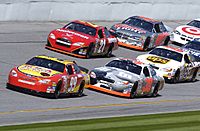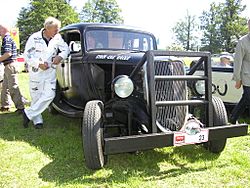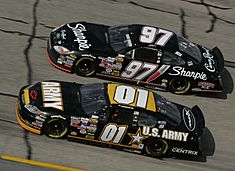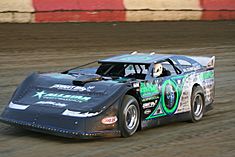Stock car racing facts for kids

NASCAR vehicles practicing at Daytona International Speedway with Jeff Burton, Elliott Sadler, Ricky Rudd, Dale Jarrett, and Sterling Marlin in 2004
|
|
| Highest governing body | NASCAR |
|---|---|
| Characteristics | |
| Contact | Yes |
| Team members | Yes |
| Type | Outdoor |
| Venue | All types of oval tracks and road courses |
Stock car racing is an exciting type of car racing. It happens on special oval tracks and road courses. These tracks can be from about 0.4 kilometers (0.25 miles) to 4.3 kilometers (2.66 miles) long.
Originally, "stock cars" meant cars that were just like the ones you could buy from a car dealer. They were "stock" or standard models. But today, the cars used in these races are built especially for racing.
This sport started in the southern United States. The biggest group that organizes these races is called NASCAR. Their NASCAR Cup Series is the top level of professional stock car racing. You can also find stock car racing in places like Australia, Canada, New Zealand, Mexico, Brazil, and the United Kingdom. Top races are usually between 320 and 965 kilometers (200 and 600 miles) long.
These powerful cars can go over 320 kilometers per hour (200 mph) on big tracks like Daytona International Speedway and Talladega Superspeedway. Modern NASCAR cars have V8 engines that produce a lot of power, around 860 to 900 horsepower. In 2007, a driver named Russ Wicks set a speed record for a NASCAR-spec car, reaching 394 kilometers per hour (244.9 mph)!
Contents
How Stock Car Racing Started
The Early Days of Racing
In the 1920s, during a time called Prohibition era, some people secretly transported illegal goods. To avoid getting caught by the police, they made their cars very fast. But they also made sure the cars looked like normal cars.
These drivers started to meet up and challenge each other to races. By the early 1930s, these challenges turned into organized events. The big problem was that every track had different rules. This made it hard for drivers to compete fairly everywhere.
A smart man named Bill France Sr. saw this problem. He decided to bring everyone together to create one set of rules. In 1948, he formed NASCAR to organize stock car racing in the U.S.
Cars That Were Really "Stock"
When NASCAR first started, the rules said that race cars had to be made from parts that anyone could buy. Also, the car models had to have sold more than 500 units to the public. This rule was called "homologation."
In those early years, the cars were so "stock" that drivers often drove their race car to the track! After World War II, car engine technology got better. NASCAR was formed just as these improvements were becoming available in regular cars. For many years, NASCAR cars were very similar to what you could buy in a showroom.
In 1949, the Oldsmobile Rocket V-8 engine came out. It was a big success in races. This led to the famous saying: "win on Sunday, sell on Monday." Car companies saw that winning races helped them sell more cars.
However, the Hudson Hornet car showed that winning wasn't just about the engine. It won many races from 1951 to 1953, even with an older engine design. This proved that a car's shape and how it handled were also very important.
Changes and Safety Rules
By 1953, the Korean War ended, and the economy grew. People started wanting more powerful engines in their cars. Also in 1953, NASCAR suggested that drivers add roll bars to their cars for safety, but it wasn't a strict rule yet.
In 1957, some big changes happened. Car manufacturers were told not to use race wins in their ads. They also couldn't directly support race teams. This was because people thought it led to dangerous street racing. But car makers still wanted to win, so they found creative ways to help teams.
Safety became a huge concern in 1957. A car crashed into the crowd at a race, hurting many people. This led to much stricter safety rules. It also encouraged building bigger, safer tracks.
NASCAR also started to control engine technology. For example, in 1957, they banned fuel injection and superchargers. These were new technologies that made cars much faster.
The "Heyday" of Stock Cars
Fans and car makers wanted even faster cars. So, companies started making special "limited production" cars. These were based on regular models but had powerful engines. NASCAR then set a rule in 1963 that engines could be no larger than 7.0 liters (427 cubic inches).
Safety rules also became even more important. Race cars needed much stronger protection than regular cars. This was because drivers experienced extreme forces during races.
In 1964, a new Chrysler engine, the 426 Hemi, was so powerful that it dominated the races. Because of this, NASCAR changed the "homologation" rule. Now, 1,000 of any engine or car had to be sold to the public, not just 500. This made the Hemi engine unavailable for the 1965 season.
Car companies kept trying to build faster, more aerodynamic cars. Ford introduced special "aerodynamic" cars like the Torino Talladega. These cars had special shapes to cut through the air better. This made them much faster.
Dodge responded by creating the Dodge Daytona. It had a pointed nose and a huge wing on the back to keep it stable at high speeds. These "aero-cars" were incredibly fast.
NASCAR worried that cars were getting too fast for the tires available. They feared more dangerous crashes. So, for the 1970 season, they changed the rules again. They hoped to slow down the use of these super-fast aero-cars. Eventually, NASCAR added "restrictor plates" to engines. These plates limit how much air and fuel can go into the engine, which reduces top speeds.
By the 1970s, NASCAR wanted races to be more about driver skill, not just car technology. Many rule changes happened in 1972, which many people see as the start of the "modern era" of NASCAR. Also, a big company called R.J. Reynolds became the main sponsor, bringing much more money into the sport. This changed racing forever.
Today, modern "stock" cars are "stock" mostly in name. They look a bit like regular cars, but they are custom-built racing machines. The parts inside are very different from what you find in a normal car. However, NASCAR and car manufacturers are working to make the race cars look more like the cars you can buy in stores.
Different Kinds of Stock Cars
A "stock car" originally meant a car that hadn't been changed from its factory design. Later, it meant any car based on a production model used for racing. This helps tell them apart from "race cars," which are built only for racing.
Today, most American stock cars might look like regular family cars, but they are actually "silhouette" cars. This means they are special racing machines built to strict rules. These rules make sure the parts like the chassis, suspension, and engine are similar in design to those in regular cars. For example, NASCAR Cup Series cars now use fuel injection.
In the UK and New Zealand, there's a type of racing called stock cars, but those cars look very different from road cars.
Street Stock and Pure Stock
"True" stock car racing, where only street-legal cars are used, is sometimes called "street stock," "pure stock," or "showroom stock" racing. In 1972, a group called SCCA started a showroom stock series for cars that cost under $3,000. Some modern showroom stock races allow safety changes to the cars.
Super Stock Cars
Super stock classes are like street stock but allow more changes to the engine. These cars usually have about 500 to 550 horsepower. The width of their tires is usually limited to 8 inches (203 mm).
Modified Stock Cars
Modified stock cars look like a mix of open-wheel cars and stock cars. The back wheels are covered, but the front wheels and engine are open. This type of racing became popular after World War II. Drivers would change passenger cars to make them faster, which is why they are called "modified." In many areas, especially on the East Coast of the U.S., modified racing is seen as the highest level of local stock car racing.
Late Model Cars
In many parts of the country, "late models" are usually the top class of stock cars in local races. The rules for building a late model car can be different depending on the region or even the specific race track. Common types include super late models (SLMs) and late model stock cars (LMSCs). A late model can be a custom-built machine or a heavily changed street car.
Different racing groups (like NASCAR, ACT, PASS) have their own rule books for late models. This means a car that is allowed in one race series might not be allowed in another without changes. The national touring series, which started from local late model races, is now called the "Xfinity Series."
See also
 In Spanish: Stock car para niños
In Spanish: Stock car para niños





